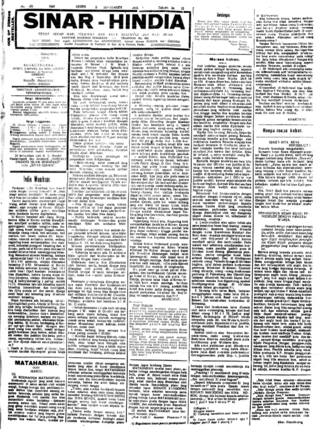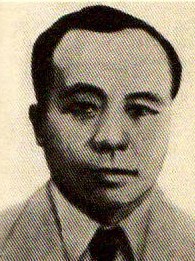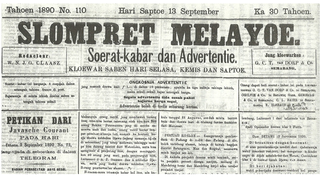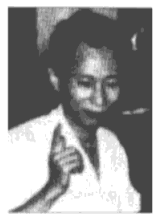
Tjahaja Timoer (Indonesian: Light of the East, EYD: Cahaya Timur) was a Malay-language Peranakan newspaper printed in Malang, Dutch East Indies, from 1907 to 1942.

Tjahaja Timoer (Indonesian: Light of the East, EYD: Cahaya Timur) was a Malay-language Peranakan newspaper printed in Malang, Dutch East Indies, from 1907 to 1942.
Tjahaja Timoer was founded in January 1907 in Malang, at around the same time as its more famous counterpart Medan Prijaji , with funding from a Peranakan Chinese firm, Sneepers dan Stendrukkkerij Kwee, or Kwee Khaij Khee as it was called in the pages of the newspaper. [1] In its early years it was a supporter of Theosophy, then popular among elites in the Indies. [2]
Despite its Chinese ownership, by the 1910s the paper was noted to be very sympathetic to the Indische Party. [3] Before long it was also expressing sympathy for the Sarekat Islam , an anti-colonial mass organisation. [2] This was due to the influence of its editor, Raden Djojosoediro, who supported both movements. [2] By 1914, while still editor of the paper, Djojosoerdiro even joined the central committee of the Sarekat Islam. [4]
In 1916 W.A. Kailola, former editor of Perniagaan , a conservative Chinese newspaper from Batavia, became the editor of Tjahaja Timoer. [5]
In 1922 the owners of Tjahaja Timoer entered into a business deal with the Soerabaijasch Handelsblad to allow their printing presses to be used to print a new Dutch language newspaper in Malang, De Oosthoekbode, with journalist Brunsveldt van Hulten as its new editor. [6] This was apparently done in a move against Jahn's Advertentieblad, a newspaper which had a monopoly in the city. Not long after it began to be printed, this new paper (the Oosthoekbode) started to circulate (via the national wire service ANETA) allegations against a former editor of Tjahaja Timoer. It alleged that this former editor, Andanjomo, in collaboration with Sarekat Islam leader Mohamed Joenoes, was terrorizing the populace of Malang and forcing native servants into a clandestine organization called Sarikat Brontak (Indonesian: Resistance Union). [7] It is unclear whether this allegation was factual because this organization was not mentioned subsequently.
Tjahaja Timoer continued to publish in Malang until the Japanese occupation of the Dutch East Indies in 1942.

Sin Po was a Peranakan Chinese Malay-language newspaper published in the Dutch East Indies and later Indonesia. It expressed the viewpoint of Chinese nationalism and defended the interests of Chinese Indonesians and was for several decades one of the most widely read Malay newspapers in the Indies. It existed under various names until 1965.

Sinar Hindia was a left-wing Malay language newspaper from Semarang, Dutch East Indies, which published from 1900 to 1924. In its later years it was the mouthpiece of the left wing of the Sarekat Islam and its editors Mas Marco Kartodikromo and Semaun were instrumental in the rise of the Communist Party of Indonesia.

Djawa Tengah was a major Malay-language peranakan Chinese daily newspaper in Semarang, Dutch East Indies from 1909 to 1938. It is said to have been the first Chinese newspaper in Semarang.

Tjhoen Tjhioe was a Malay language Peranakan Chinese newspaper from Surabaya, Dutch East Indies catering mainly to the Chinese population. The full title of the paper was Tjhoen Tjhioe: Soerat kabar dagang bahasa Melajoe jang moeat roepa kabar penting bagi bangsa Tionghoa. Although the paper only existed for a short time, during that time it was recognized as one of the top Chinese newspapers in the Indies, alongside Sin Po and Perniagaan.
Sie Hian Ling, who sometimes signed his works H.L. Sie, was a Peranakan Chinese journalist from Semarang, Dutch East Indies. He was one of the first Chinese journalists in the Indies and an early translator of Chinese novels.

Kwee Thiam Tjing Sia, also known by his pen name Tjamboek Bērdoeri ['Thorn Whip'], was a prominent Indonesian writer, journalist and left-wing political activist. He is best remembered for his 1947 book, 'Indonesia dalem Api dan Bara', and for his role as a co-founder of the Partai Tionghoa Indonesia [the 'Chinese-Indonesian Party'] in 1932.
The 1918 Kudus riot was an anti-Chinese riot that took place in the city of Kudus, Semarang Regency, Dutch East Indies, on October 31, 1918. In the riot, Javanese townspeople burned and looted the Chinese district, resulting in roughly 10 deaths and dozens of injuries, and causing half of the Chinese population of the city to flee to Semarang and other cities in Java.

De Preangerbode was a Dutch language newspaper published in Bandung, Preanger Regencies Residency, Dutch East Indies from 1896 to 1957. After 1923 it was renamed Algemeen Indisch Dagblad de Preangerbode.

Ang Jan Goan was an Indonesian Chinese journalist, publisher and political thinker, and director of the influential newspaper Sin Po from 1925 to 1959.

Neratja, later Hindia Baroe, was a Malay language newspaper printed from 1917 to 1926 in Weltevreden, Dutch East Indies. Although originally founded with government support to be a Malay voice for the Dutch Ethical Policy, before long it became associated with the Sarekat Islam and the Indonesian National Awakening. Among its editors were important figures of the Indonesian national movement such as Abdul Muis and Agus Salim.
Parada Harahap was an important journalist and writer from the late colonial period and early independence era in Indonesia. In the 1930s, he was called the "king of the Java press". He pioneered a new kind of politically neutral Malay language newspaper in the 1930s which would cater to the rising middle class of the Indies.

Algemeen handelsblad voor Nederlandsch-Indië was a Dutch language newspaper which was published in Semarang, Dutch East Indies from 1924 to 1942.

Het Vrije Woord was a left-wing newspaper printed in the Dutch East Indies from 1915 to 1922, associated with the Indische Sociaal-Democratische Vereeniging and the Indonesian Communist Party in its early years.

Selompret Melajoe was one of the first Malay language newspapers to publish in the Dutch East Indies. It was printed in Semarang, Central Java from 1860 to 1920.
Jacobus Rudolph Razoux Kühr, commonly known as J. R. Razoux Kühr or Jack Razoux Kühr was an Indo civil servant and businessman from the Dutch East Indies largely remembered for being one of the first editors of the popular Chinese Indonesian newspaper Sin Po.

Hauw Tek Kong (1887-1928) was a Peranakan Chinese newspaper editor and publisher from the Dutch East Indies associated with Sin Po and later Keng Po.

Pewarta Deli was a Malay language newspaper published in Medan, Dutch East Indies from 1910 until 1941, and again from 1945–6. During its run the paper became a strident anti-colonial voice, sympathetic to the Sarekat Islam and Indonesian nationalism and critical of the cruelty of big business in Medan's tobacco and plantation industries. It also gave space in its pages to Communism and Islamic modernism. The paper had a wide readership in its time, with an influence not only in the Indies, but also among Malays in British Malaya.

Njonja Tjoa Hin Hoei, who was born Kwee Yat Nio and was also known by the Buddhist name Visakha Gunadharma, was a Chinese Indonesian journalist, writer, Buddhist figure, and political activist during the late colonial and early independence periods. She was especially known for being publisher and editor of a women's magazine Maandblad Istri which ran from the 1930s to the early 1950s.

Injo Beng Goat was a Chinese Indonesian journalist, lawyer, and political activist of the late Dutch East Indies and early independence era in Indonesia. He was editor-in-chief of Keng Po, one of the largest newspapers of the early independence period, until 1958.

Sinar Sumatra was a Malay-language newspaper published in Padang, Dutch East Indies from 1905 to around 1941 or 1942. It is generally considered a Peranakan Chinese publication, although it had European publishers and Minangkabau editors as well. During the pre-World War II period it was one of the most widely-read Malay language newspapers in Sumatra.